Some nomadic handicrafts of Iran
Nomadic hand-wovens manifest their courage, art, creativity, nature-friendliness, and hard work. The nomadic people of Iran, from Baluch, Qashqai, Bakhtiari, etc., have lived a loving and peaceful life together. Along with this life, they have created tools, some of which have gained world fame.
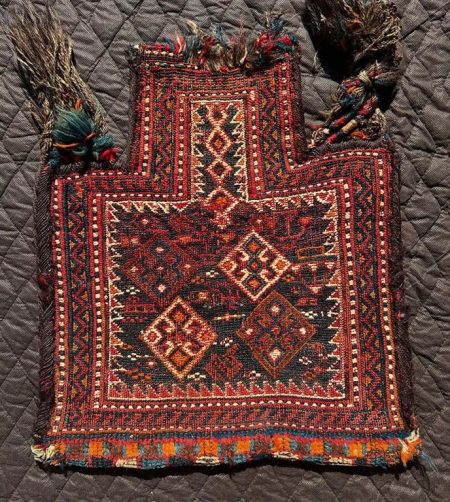
old Bakhtiari saltbag
Nomadic handicrafts such as salt bags(namakdan), rugs, saddlebags(khorjin), chanteh(bag), etc, are famous. Some of these valuable heritages have faded and are being forgotten. The entire production process of these tools is done by the nomads. These processes are picking wool, spinning, and dyeing it. In the following, we will introduce you to some of these handicrafts. Stay with us!
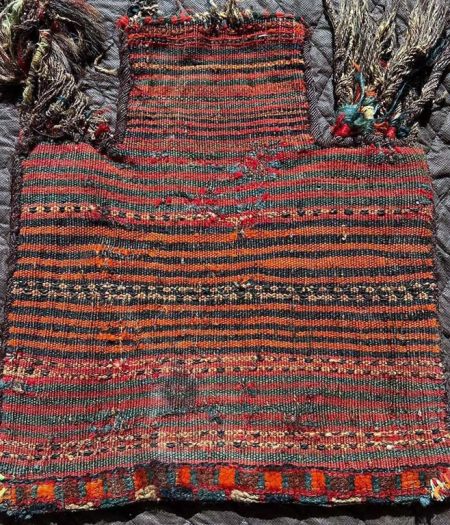
back of old Bakhtiari saltbag
What is a Persian salt bag?
In the nomadic culture of Iran, salt has had a special value and meaning since the distant past. Respecting bread and salt is a characteristic of Iranian people. Salt is considered one of the most precious blessings of God in the nomadic culture. It Reminds us of good qualities such as chivalry, gratitude, and honesty. This is the reason why Iranian people swear by salt and value it a lot.
Salt bag(Namakdan) weaving is generally attributed to the Afshar tribes, the Bakhtiari, the Lors, the Shahsevan tribes, and the Baluch. Almost all the nomads of Iran except the Turkmen tribe have nomadic salt bag weaving. Among these nomads whose names were mentioned, the Afshar tribe of Kerman is one of the biggest producers of salt bags. These handicrafts are woven by nomadic women like Persian hand-woven rugs.
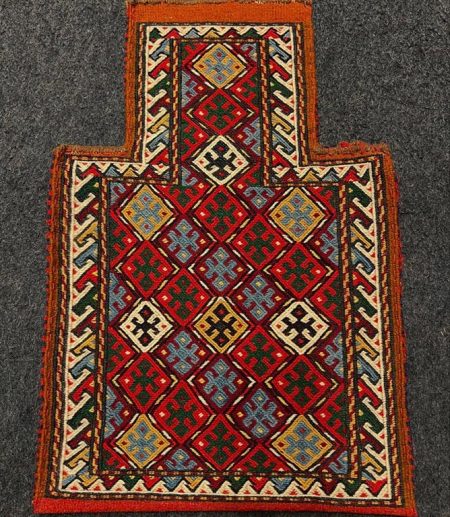
kormanj saltbag
Structure of salt bag
If you pay attention to the structure of the salt bag, you will realize its importance and sanctity. The configuration of the salt bag includes a throat and a body, reminiscent of the human body. The salt bag also resembles carpets with a prayer design.
The front of it is woven with a special kilim knot. The back is usually striped and in the form of a kilim. The end of the salt bag is woven like a carpet due to its strength. Both sides are wrapped with goat hair. For its interior, the cotton cloth is used as a lining, which also helps to dry the salt inside. Also, this fabric prevents salt from coming into contact with wool. Constant contact of salt with wool causes wool to rot.
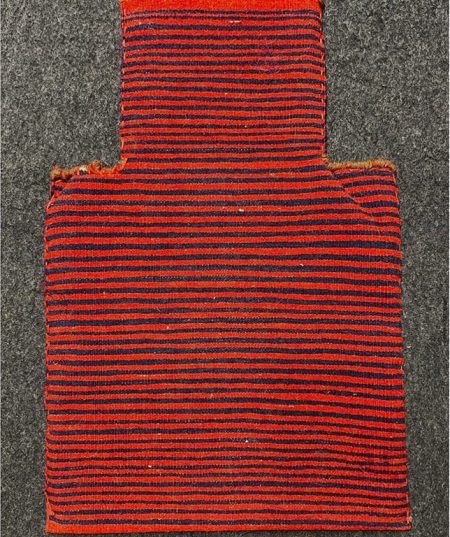
back of kormanj salt-bag
Use of salt bag
Salt bags are used to store and carry coarse and ground salt for shepherds so that they can supply the salt needed by the herd. The salt bags are also used to store other agricultural products such as barley, wheat, and beans. In addition to the consumption of shepherds, nomads need salt for their daily life. The nomads put the salt in these bags hang them from their tents and use them for cooking. Grinding salt is difficult to obtain and taking care of it is essential for nomads.
The designs of salt bags are diverse. Among these designs, we can mention the pattern of ponds, stripes, geometric polygons, fish, birds, flowers, and plants. The colors used in salt bags are red, blue, yellow, brown, green, and white. If you are planning to buy a salt bag, you can see examples in this section.
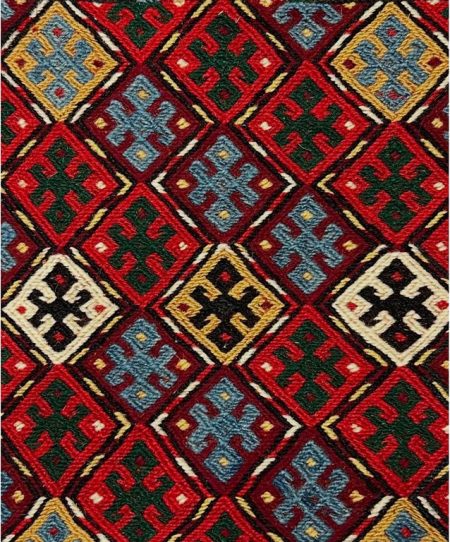
Details of Kormanj salt bag
Tips for maintaining a salt bags
- Keep away from moisture.
- Keep away from heat.
- Keep away from continuous sunlight.
- Lukewarm water and ordinary detergent are used to wash them.
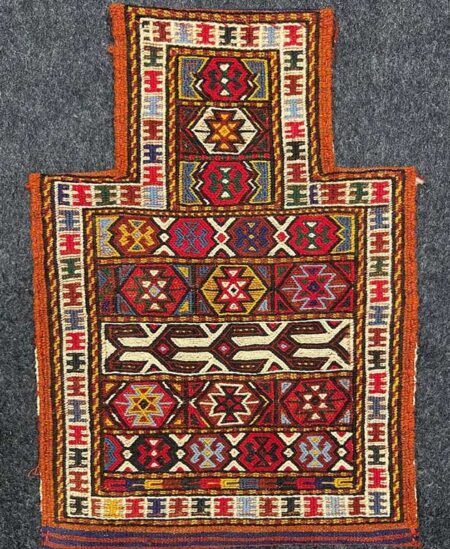
Afshar salt bag, 35*50 cm
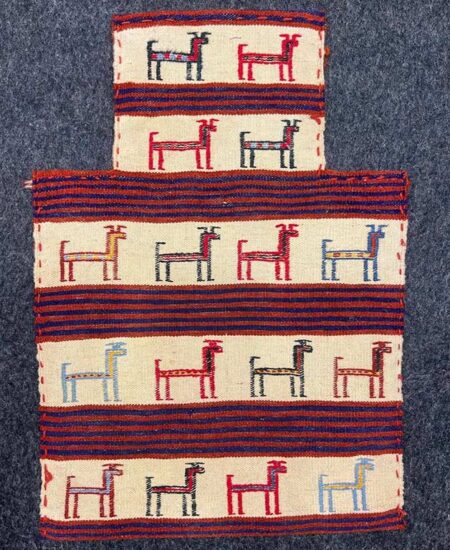
Back of salt bag
Chanteh
A chanteh or bag is another nomadic handicraft. Chanteh is defined in the Dehkhoda dictionary as “a bag for dervishes, which is made of carpet material and sewn like a bag, and is embroidered with leather around it and hung from the neck.”
In this century, few people think about camping. Now the nomads have packed their tents and turned to the urban lifestyle. For this reason, it is not customary to use a nomadic bag to carry personal belongings as in the past. The nomads used bags to transport salt and flour.
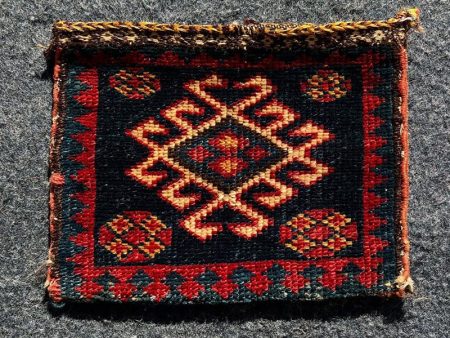
chanteh
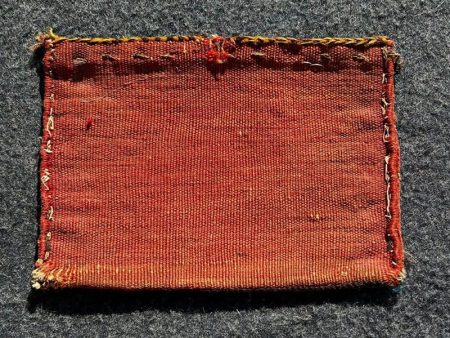
back of old Bakhtiari chanteh
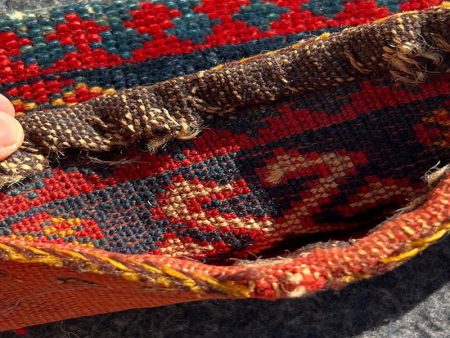
inside of Chanteh
You can read:
Structure of chanteh
The bag consists of two parts. The front is woven like a carpet and the back is woven like a jajim. The dimensions of the bag are usually 30 x 40 cm. This bag is sewn on three sides and one side remains open. Finally, a rope is woven into it and used as a bag.
Symmetrical and asymmetrical knots are used to weave it. The raw material of the bag is wool and a horizontal loom is used. Due to its small width, the weaver can weave 10 to 20 bags at the same time when setting up the loom. Various designs are used in the weaving of the bag, including peacock, bote-jegheh, bird, and geometric designs.
If you are planning to buy a chanteh, you can see examples in this section.
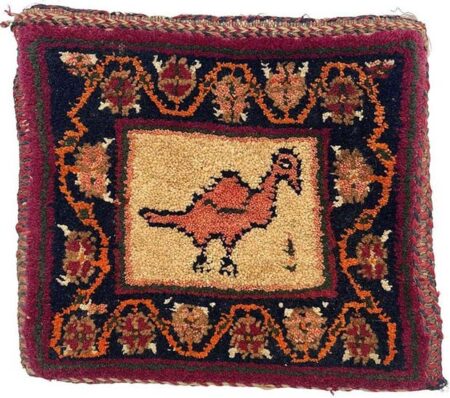
Antique Afshar chanteh
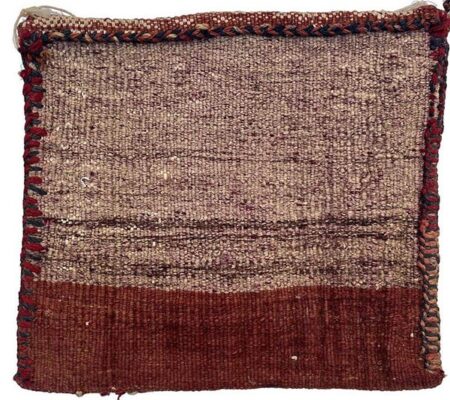
Antique Afshar chanteh
What are Persian saddle bags?
Saddle bags or khorjin are two symmetrical bags that are connected. Each bag is installed on the sides of the pack animals such as horses and donkeys. The nomads put their tools and necessities in it. Nomads were constantly on the move and they needed a suitable and durable device to carry their goods such as dairy products, curds, and oil. That’s why they produced saddle bags.
The nomads’ routes were always difficult to cross. They used various techniques to weave the double saddle bag so that it would not be damaged by contact with rocks. Saddle bag is also used as a bag and fund. To weave it, they used goat hair for the warp and sheep wool for the base.
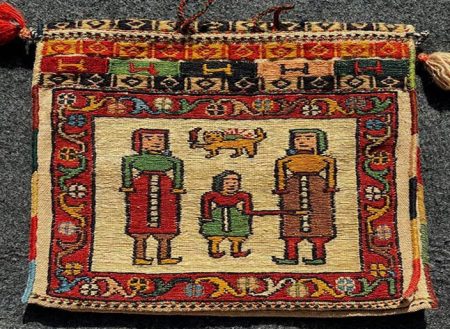
Qashqai saddle bag
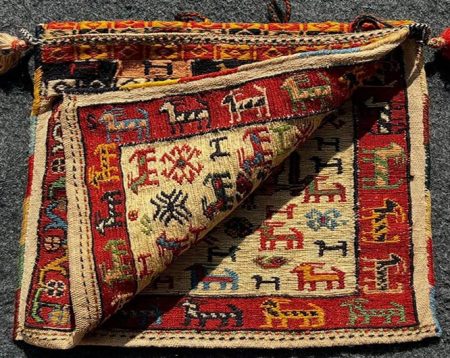
Inside of saddle bag
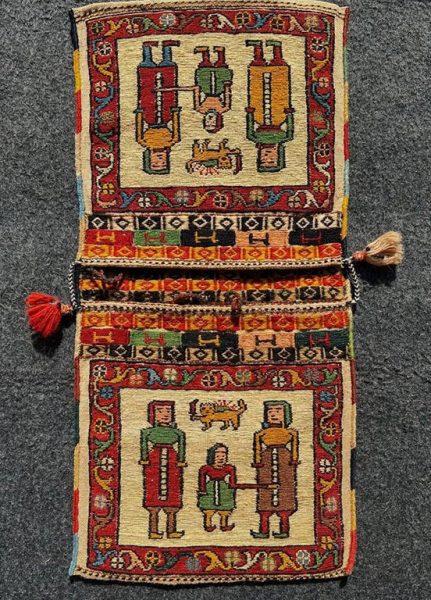
both sides of saddle bag
All things about Gabbeh, other Persian nomadic handicrafts:
Types of saddlebags
Saddlebags have many uses and are woven in various sizes. They can be divided into three categories: small, normal, and large. Saddlebags that are prepared in small sizes consist of two squares that are sewn on a rectangle. This type is used to store documents and valuables or ornaments. Nomadic women hang them in front of the saddle of their horses while riding and place their belongings inside.
The second type, which are ordinary saddlebags. They are woven in the size of 100 x 50 cm and are used for moving food and living tools. The third type them are woven in dimensions of 150 x 100 cm and larger dimensions. Their pockets are rectangular and they are often woven in Chaharmahal-Bakhtiari province. It is either woven by knotting like a carpet or it is done with a spinning machine like a nomadic tent.
Saddle bag patterns also have a lot of variety, but more than geometric elements are designed on them. Currently, due to the settlement of nomads, the weaving of it is not like in the past. The Ardabil saddlebags are of higher quality and more durable than the saddlebags that are woven in Iran. You may be planning to buy a saddlebag, so please check this section.
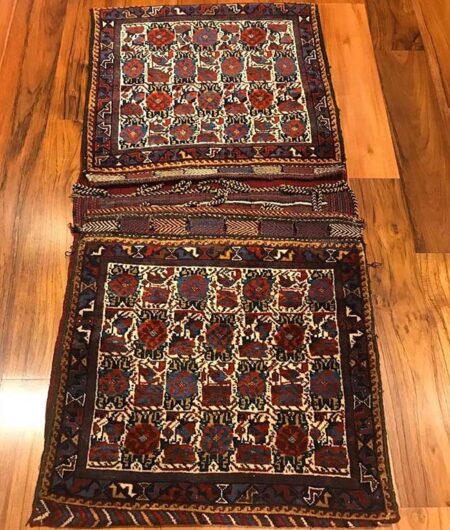
Antique Afshar khorjin circa 1900s

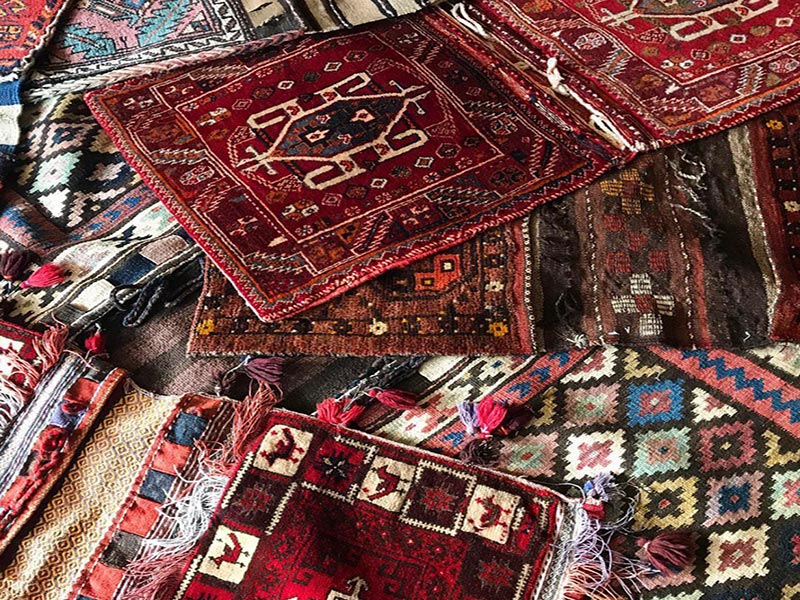
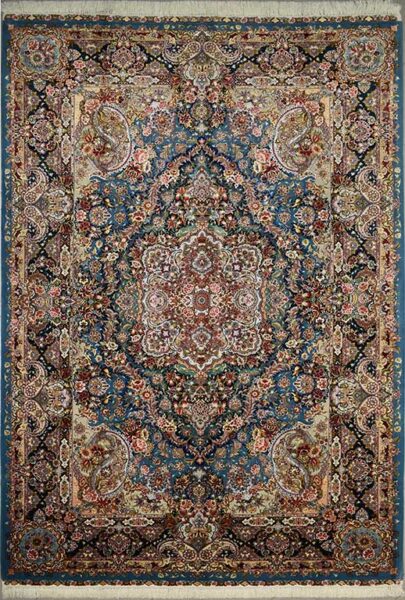

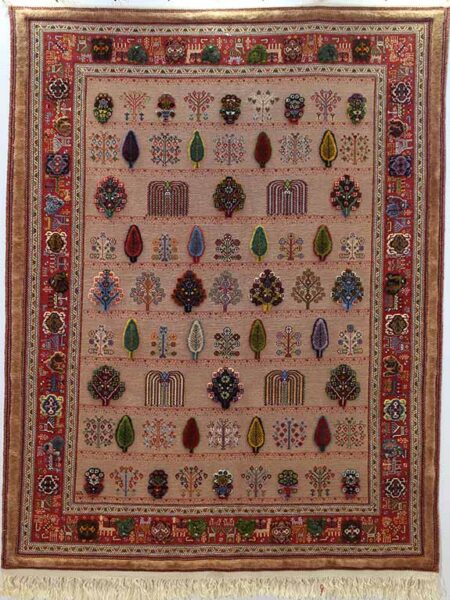
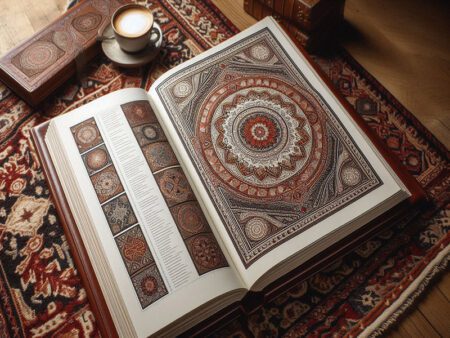

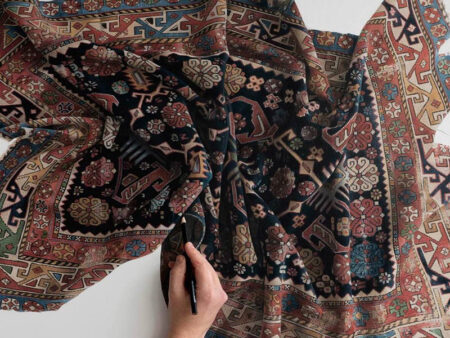






One thought on “Getting to Know Some Persian Nomadic Handicrafts, Salt Bag, Chanteh, and Saddlebag”